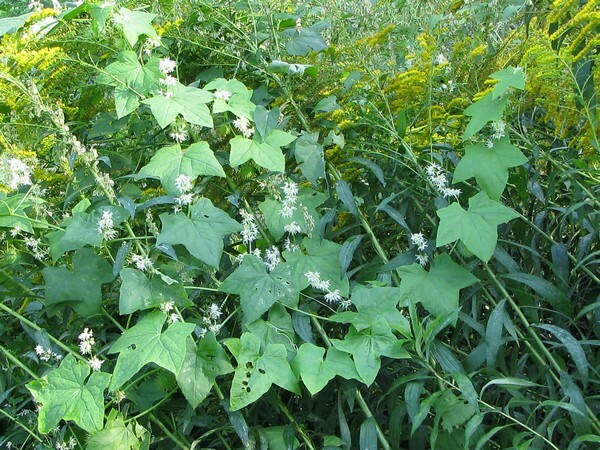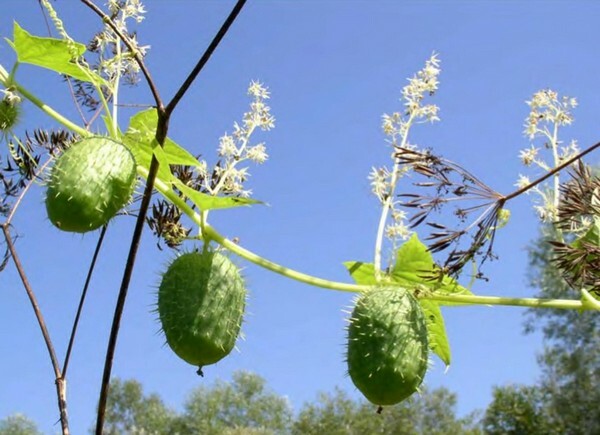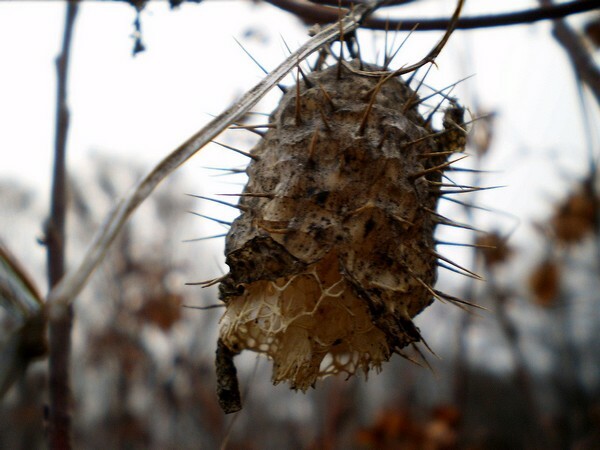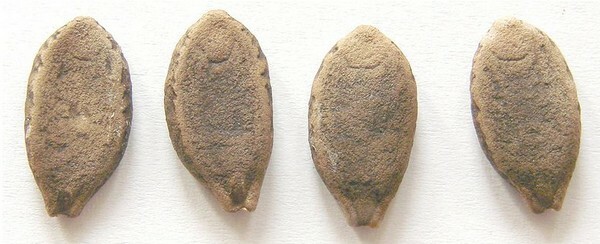Echinocystis prickly - an annual herbaceous plant, the only representative of the genus Echinocystis, belonging to the family Pumpkin. In nature in the wild it is common in the eastern regions of Canada and America. However, at present it can be found in Siberia, Central Asia, Europe, Japan, the Far East and other regions in which it was brought by man. Echinocystis is very unpretentious in the care of a plant, it multiplies easily by self-seeding, in connection with which some gardeners and gardeners perceive it as a weed. Nevertheless, many people grow it specially for decorative purposes for vertical landscaping. Among other plant names, there is echinocystis or lynx fusiform, echinocystis or larvae of lobular, pemphigus, needley cucumber, ivy, chrysanthemum, etc.

Botanical description
Echinocystis spiny grows in wasteland, along roads, near dwellings, in gardens, in country plots,water reservoirs( ponds, streams and rivers), on coastal bushes.
The plant is propagated by seeds that are sown under winter by nesting, placing 2 to 3 seeds in each nest at a depth of 3 to 5 cm. In spring, the shoots, if necessary, are thinned out. A light, humidified, air-and moisture-permeable soil with a neutral pH reaction is well suited to the larvae. In dry and hot weather requires abundant watering( at the rate of 4 - 5 liters per plant), otherwise slows down development and begins to turn yellow. The rest of the time, rain watering is enough.
Root system and stems
A type of larvae is a rapidly growing liana, the length of which can reach 10 m. The root system is friable. The growth of the plant is very fast in the direction upwards and to the sides. If there is no support near the echinocystis, then it can spread along the grass, bushes and even climb trees, completely braiding them from above with their shoots.
Stems thin, glabrous, strongly branched in nodes, angular-grooved in cross-sectional shape. With the help of strong twisted branched tendrils, it is able to cling to the support.
Leaves
The leaves on the stalk are located on long fleshy rough petioles the next time, are painted in pale green color. In structure they are thin, smooth, at the base are deep-draining. Some leaves can be modified into antennae. The leaf plate is round or ovate in size 5-15 cm, divided into five blades with sharp ends of triangular shape, the apical lobe is always wider and longer than the others.
Flowers and Fruits
Echinocystis spiny is a monoecious plant. Flowers are dioecious, fairly small and inconspicuous in appearance, while females are larger than males. Corolla deeply six-parted, with lanceolate or linear curved sharp petals, painted white or cream-white, its length is 5-7 mm, and diameter - 7-12 mm. Female flowers are solitary, one or two in the axils of the leaves. Men are collected in the inflorescence of the brush( candle) and are located above the female on one shoot. The plant is pollinated by insects and wind. When the wind blows, the pollen from the male flowers flies and falls down on the female.
The flowering period lasts from June to September.
Interesting: From male( staminate) flowers of echinocystis, a subtle honey aroma emanates, attracting bees to collect pollen and nectar.

Fruit - a box( tykvina) of oval form, ripens from August to October. Its length is 4 - 5 cm, and width - 3 - 4 cm. Outside it is covered with sparse soft spines, inside is fibrous. When they appear, they have a blue-green color, juicy, and then turn yellow and dry and open at the top, throwing out the seeds. During the growing season, one plant can produce 10 to 40 fruits. Inside each fetus, there are four seeds, each of which is two in two stiff-necked nests. Seeds of flattened oblong-oval form 10-18 mm long, painted in dark brown color.

Application
Blade kosheplodnik has found wide application as an ornamental plant. It is used to decorate balconies in apartments, fences, hedges, verandas, arches, arbours in suburban areas and in landscape design. He is able in the shortest possible time, clinging to the antennae for support, to form a picturesque hedge that will become an ornament of the territory. The plant covers a solid layer of greenery area of 6 - 8 m2.The greatest decorative value it represents in the period of fruiting, when its stems immediately have leaves, and antennae, and elegant inflorescences, and unusual fruits.
Also the plant is used as a decorative material for making floral compositions. It can be used as an independent decor element or in combination with other plants, in combination with live or dried flowers. Dry fruits of echinocystis are excellent for making various crafts.
In North America, the larva is used for medicinal purposes. In the roots of the plant contain bitterness, which has analgesic activity, so tea from them helps with headache. On the territory of Russia, the healing properties of echinocystis have not been studied at the moment.
The fruits of the plant contain enzymes, calcium and potassium salts, pectin substances that are useful for the human body. They are considered edible, and some people consume them, adding them to the salad. To taste, they resemble cucumbers. Seed seeds of echinocystis are also edible. They are eaten in fried form, sometimes added to pastries.

Echinocystis is a good honey, for which many beekeepers appreciate it. The honey obtained from it is colorless, aromatic and pleasant to the taste.
Warning: Prolonged exposure to echinocystis can cause dizziness, an allergic reaction and general weakness, especially children and women are susceptible to its scent.
Echinocystis and furious cucumber
Echinocystis spiny( Echinocystis lobata) is often confused with another plant-like plant - the rabid cucumber( Ecballium elaterium), which also belongs to the Pumpkin family. Plants are a bit like the shape of the fruit and the peculiarity of their opening, throwing seeds.
However, unlike echinocystis, a rabid cucumber:
- is a perennial plant;
- releases seeds at high speed( they fly out of the fetus under pressure, and the echinocystis calmly falls down);
- has creeping stems, rough leaves, small black seeds with mucus and yellow flowers that do not smell;
- is used in folk medicine as a diuretic, antibacterial, laxative.
